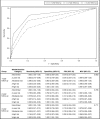Predictive Validity of a 2-Question Alcohol Screen at 1-, 2-, and 3-Year Follow-up
- PMID: 30783022
- PMCID: PMC6398369
- DOI: 10.1542/peds.2018-2001
Predictive Validity of a 2-Question Alcohol Screen at 1-, 2-, and 3-Year Follow-up
Abstract
Background: The National Institute on Alcohol Abuse and Alcoholism (NIAAA) 2-question screen is a valid adolescent alcohol screening tool. No studies have examined if this tool predicts future alcohol problems. We conducted a study at 16 pediatric emergency departments to determine the tool's predictive validity for alcohol misuse and alcohol use disorders (AUDs).
Methods: Participants (N = 4834) completed a baseline assessment battery. A subsample of participants completed the battery at 1, 2, and 3 years follow up.
Results: Of the 2209 participants assigned to follow-up, 1611 (73%) completed a 1-year follow-up, 1591 (72%) completed a 2-year follow-up, and 1377 (62%) completed a 3-year follow-up. The differences in AUDs between baseline NIAAA screen nondrinkers and lower-risk drinkers were statistically significant at 1 year (P = .0002), 2 years (P <.0001), and 3 years (P = .0005), as were the differences between moderate- and highest-risk drinkers at 1 and 2 years (P < .0001 and P = .0088, respectively) but not at 3 years (P = .0758). The best combined score for sensitivity (86.2% at 1 year, 75.6% at 2 years, and 60.0% at 3 years) and specificity (78.1% at 1 year, 79.2% at 2 years, and 80.0% at 3 years) was achieved by using "lower risk" and higher as a cutoff for the prediction of a Diagnostic and Statistical Manual of Mental Disorders, Fifth Edition diagnosis.
Conclusions: The NIAAA 2-question screen can accurately characterize adolescent risk for future AUDs. Future studies are needed to determine optimaluse of the screen.
Copyright © 2019 by the American Academy of Pediatrics.
Conflict of interest statement
POTENTIAL CONFLICT OF INTEREST: The authors have indicated they have no potential conflicts of interest to disclose.
Figures
Comment in
-
Alcohol Use Disorder: A Pediatric-Onset Condition Needing Early Detection and Intervention.Pediatrics. 2019 Mar;143(3):e20183654. doi: 10.1542/peds.2018-3654. Epub 2019 Feb 19. Pediatrics. 2019. PMID: 30783023 Free PMC article. No abstract available.
References
-
- National Institute on Alcohol Abuse and Alcoholism Alcohol screening and brief intervention for youth: a practitioner’s guide. 2011. Available at: www.niaaa.nih.gov/YouthGuide. Accessed December 15, 2017
-
- Kokotailo PK; Committee on Substance Abuse . Alcohol use by youth and adolescents: a pediatric concern. Pediatrics. 2010;125(5):1078–1087 - PubMed
-
- American College of Emergency Physicians Alcohol screening in the emergency department policy statement. 2011. Available at: https://www.acep.org/patient-care/policy-statements/alcohol-screening-in.... Accessed January 13, 2019
-
- American College of Surgeons Committee on Trauma Resources for optimal care of the injured patient, Sixth Edition. 2014. Available at: www.facs.org/quality-programs/trauma/tqp/center-programs/vrc. Accessed January 13, 2019
-
- Substance Abuse and Mental Health Services Administration. Screening, brief intervention and referral to treatment. 2017. Available at: www.samhsa.gov/sbirt. Accessed January 13, 2019


